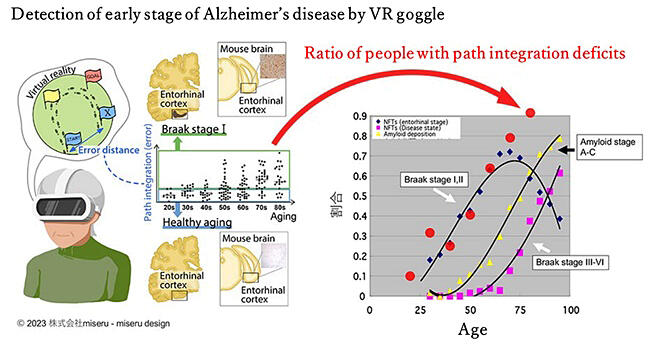A research group led by Graduate Student Riki Koike, Assistant Professor Yoshiyuki Soeda, and Professor Akihiko Takashima of the Department of Life Science of the Faculty of Science at Gakushuin University, along with researchers at Fujita Health University, Shiga University of Medical Science, and the University of Tokyo announced their novel virtual reality (VR) goggle-based method to detect brain abnormalities before onset of Alzheimer's disease. The researchers focused on the entorhinal cortex and developed a VR goggle-based method to measure path integration ability, a spatial cognitive function in the brain. The method was successfully applied to detect neurofibrillary changes in the entorhinal cortex, the initial lesion leading to Alzheimer's disease. These findings are expected to contribute to the prevention and treatment of Alzheimer's disease and were published in the international academic journal Brain Communications on February 12, 2024.

Provided by miseru design
The brains of patients with Alzheimer's disease demonstrate β-amyloid and phosphorylated tau accumulation in cells (neurofibrillary changes). These neurofibrillary changes, which first appear in the entorhinal cortex and spread to the limbic system and then to the neocortex, gradually cause a decline in brain function. The rate of brain function decline is accelerated by β-amyloid accumulation. The entorhinal cortex is located in the medial temporal lobe, and its grid cells provide spatial location information. When moving from one point to another in space, navigation-related regions centered around the entorhinal cortex, including the hippocampus and frontal lobe, are activated. The identification of lesions in the entorhinal cortex could allow Alzheimer's disease prevention. However, these lesions cannot be detected by cognitive function tests for diagnosing dementia, such as the Mini-Mental State Examination (MMSE).
In the current study, the research group examined if neurofibrillary changes in the entorhinal cortex, the initial lesion leading to Alzheimer's disease, could be detected by measuring navigation functions using VR goggles.
First, the researchers investigated the association between the accumulation of "phosphorylated tau" protein in the entorhinal cortex, which is known to be related to dementia onset in Alzheimer's disease, and the deterioration of the brain spatial cognitive function termed "path integration ability." Path integration is the ability to memorize the distance and direction of travel and to return to the starting point or to reach a destination. This integration is processed in the entorhinal cortex. The team developed a VR goggle-based method to measure path integration ability. Specifically, the method measures the activity of grid cells as path integration error distance using VR goggles.
The study participants were directed to walk a triangular path in the virtual space projected by the VR goggles and to return to the starting point. The accuracies of the distances and directions that they walked were assessed.
The results revealed correlations between the proportions of participants with reduced path integration ability and those with neurofibrillary changes in the entorhinal cortex in each age group. Among participants in their 20s to 90s with no memory impairment, the proportion of individuals above a threshold corresponded with the proportion of individuals with entorhinal cortex lesions reported in a cross-sectional study using brains examined during autopsies. Moreover, mice with phosphorylated tau accumulation in the entorhinal cortex showed reduced path integration ability, which confirmed the association between neurofibrillary changes in the entorhinal cortex and reduced path integration ability.
These results suggested that abnormalities in path integration ability may be the first manifestation of Alzheimer's disease. Measurement of path integration ability using VR goggles is expected to be used widely because the method is simple, non-invasive, and low-cost.
According to Takashima, "Alzheimer's disease is a tragic disease that causes a loss of self at the end of life. However, it is a preventable disease if found at an early stage. Before 80 years of age, more than 90% of adults with a healthy brain will reach a condition that may progress to a diseased state. After reaching this condition, Alzheimer's disease develops within 20 to 30 years. In hopes of reducing the number of Alzheimer's disease patients to zero, we developed a behavior assessment method that reflect pathological changes in Alzheimer's disease, rather than cognitive function. We succeeded in discriminating pathological brain aging before the onset of cognitive decline. We hope that many people will use this method to prevent Alzheimer's disease."
Journal Information
Publication: Brain Communications
Title: Path integration deficits are associated with phosphorylated tau accumulation in the entorhinal cortex
DOI: 10.1093/braincomms/fcad359
This article has been translated by JST with permission from The Science News Ltd. (https://sci-news.co.jp/). Unauthorized reproduction of the article and photographs is prohibited.




